Thanksgiving 2025 in Bloom: Regional Floral Trends from Coast to Coast
Explore 2025's top Thanksgiving floral trends from coast to coast. A designer's guide to regional aesthetics, from Northeast Vintage Prep to Pacific Northwest Organic Elegance, helping you create a tablescape that tells a story of gratitude.
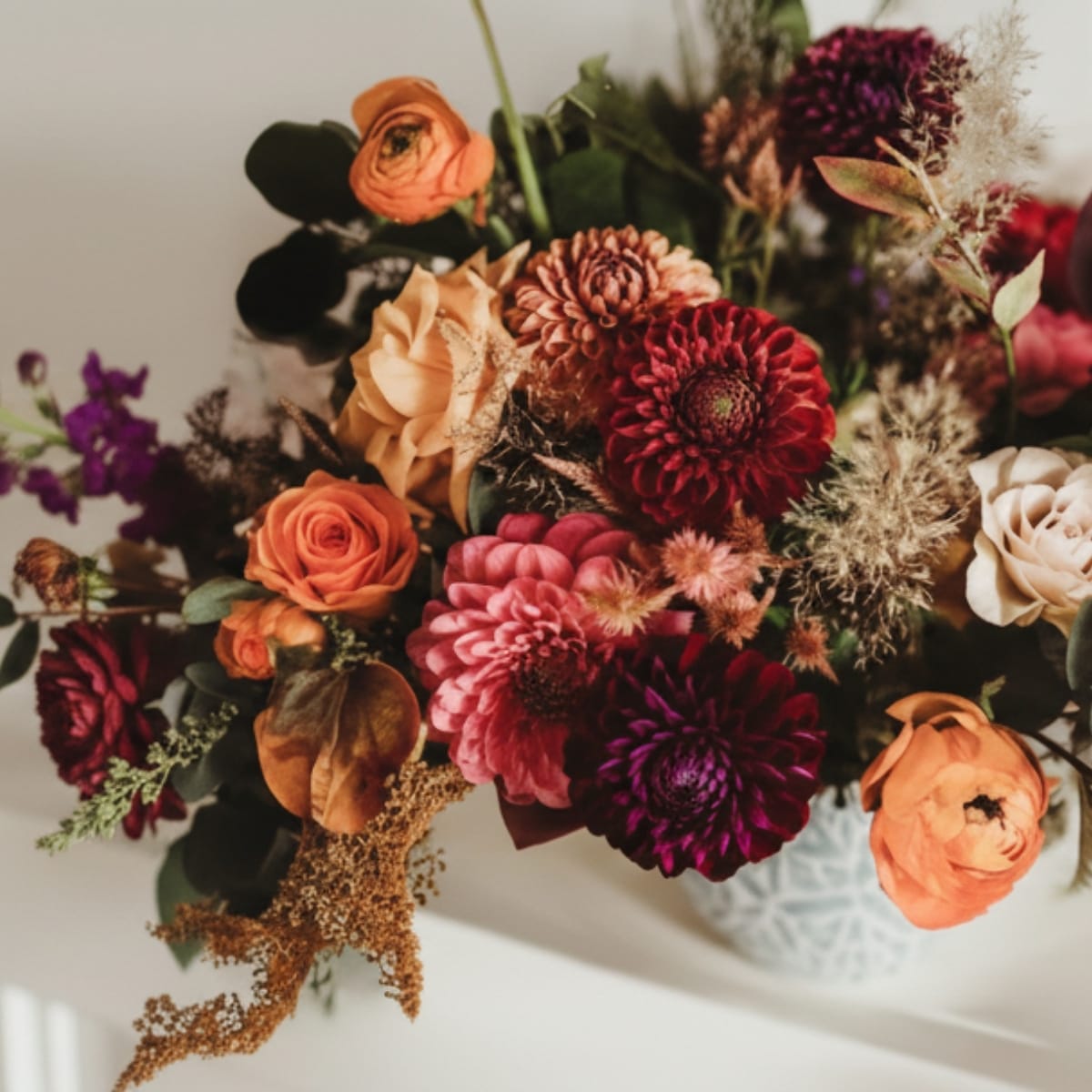
By Emily Limas, Founder & Lead Designer at Grace & Blooms
AS FEATURED IN
AP News • WFLA NBC 8 • WGN-TV Chicago • Rochester First • Canadian Real Estate Today
A Note from Emily
Hello! I’m Emily, the designer and founder behind Grace & Blooms. My creative home is here in Naples, Florida, where I draw endless inspiration from the effortless elegance of the coast and the vibrant, ever-changing colors of the Gulf.
My deepest passion is translating personal stories and seasonal gratitude into sophisticated floral compositions that feel both timeless and deeply personal. While our studio is rooted in the tropics, our design philosophy is national in scope.
This guide is my way of sharing the beautiful insights and trends I gather from coast to coast, offering you a bit of design education grounded in real materials, sensory detail, and a deep commitment to quality and longevity.
Every bloom tells a story.
TL;DR: The 2025 Regional Floral Snapshot
- Northeast: Embrace Vintage Prep with layered heirloom details, velvet ribbons, and deeply saturated jewel tones like burgundy and emerald for a cozy, generational feel.
- South: Focus on Coastal Warmth using dramatic, structural foliage like Magnolia leaves paired with sophisticated Hydrangea and Amaryllis blooms for an effortlessly elegant statement.
- Midwest: Interpret Meadow Modernism through abundant, textural designs featuring robust Dahlias, grasses, and dried elements that signal a refined, practical luxury.
- Mountain West: Design Architectural Statements that capture the landscape’s scale, using structural branches, negative space, and formal flowers like Phalaenopsis Orchids.
- Pacific Northwest: Champion Intentional Imperfection with foraged-style, asymmetrical compositions that honor sustainability and a deeply verdant, forest-green palette.
America in Bloom: A Design Perspective on Thanksgiving 2025
This Thanksgiving, the table is far more than just a gathering place. It is a carefully crafted narrative of gratitude and regional identity. As a designer, I see the beauty in how a single centerpiece can tell a complete story, connecting a home to the authentic heart of the season, regardless of the local climate.
For 2025, luxury lies in honoring this geographic nuance. The true mark of a sophisticated host is the intentionality woven into every detail, particularly the blooms that serve as the emotional anchor for your most cherished holiday.
From the rugged peaks of the Mountain West to the misty forests of the Pacific Northwest, America’s design trends are diverging into distinct, highly personal expressions of harvest and home. We are moving beyond a universal Thanksgiving aesthetic and into an era of authentic, localized beauty.
This guide explores the five major regional floral trends for 2025, offering design insights, sensory details, and professional tips to ensure your tablescape is a memorable reflection of your unique story.
The Northeast: Heritage & Heirlooms (The Vintage Prep Trend)
The Northeast Thanksgiving table is an exercise in cozy, generational layering. Grounded in tradition but polished for a modern host, the 2025 Vintage Prep trend speaks of ancestry, quality craftsmanship, and the comforting weight of history.
The aesthetic focus shifts from bright autumn reds to the deeply saturated jewel tones of early winter. Rich burgundy, forest green, and complex mustard yellow. It’s a palette that feels gathered, not manufactured.
The Palette of Legacy: Muted Golds and Dusty Rose
The color story here is built on a richness that feels personal and curated. Think of the soft patina of aged brass candlesticks, the softened hue of antique linens, and the tactile quality of a velvet ribbon tied loosely around a napkin. Blooms should feel classic and substantial, chosen for their structure and emotional resonance.
- Amaryllis: Often used as a commanding focal point in deep crimson or creamy white, it symbolizes pride and stately beauty.
- Roses: Premium, garden-style roses in muted, dusty tones add a layer of romance and texture.
- Heirloom Mums: Large, deeply textured chrysanthemum blooms anchor the arrangement in tradition and seasonal abundance.
The vessels are frequently inherited pieces. A pewter urn, a grandmother’s cut-crystal bowl, or collected porcelain giving the arrangement an immediate, personal story.
The design uses verticality and weight to command attention, accented by tall, tapered beeswax candles that cast a warm, flickering glow, enhancing the mood-driven lighting of a late November afternoon.
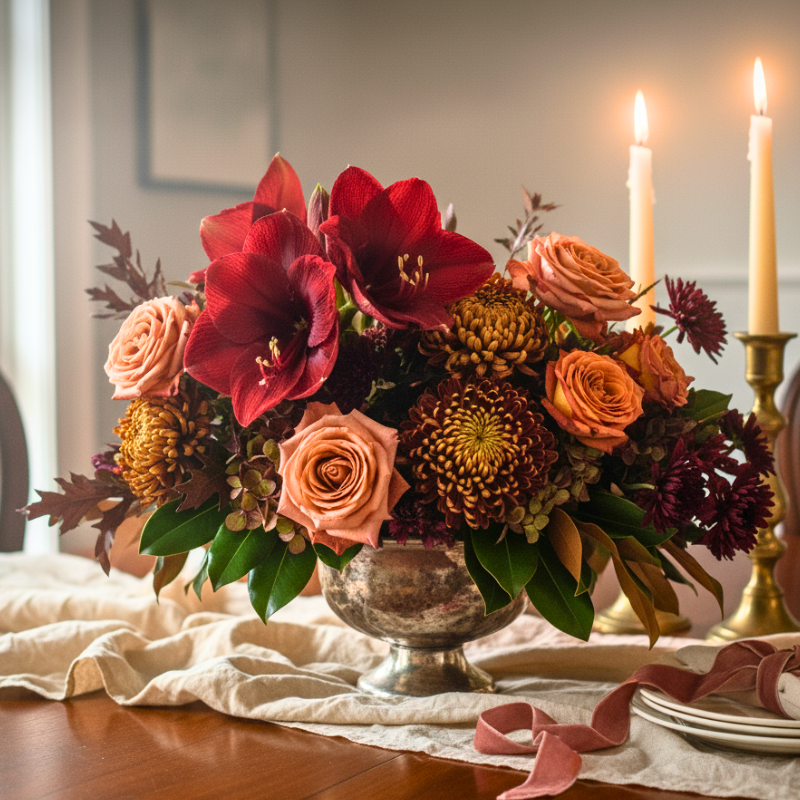
Conditioning Insight: Maximizing Floral Longevity
Working with heirloom-quality flowers requires technical precision to ensure they last through a long holiday weekend. For instance, a professional florist will condition hollow-stemmed flowers like Amaryllis by securing the stem base with tape or inserting a thin wire to offer internal support, preventing premature curling.
The secret to keeping those deep, rich colors so vibrant lies in professional conditioning. We use meticulous hydration techniques and a nutrient-rich flower food to ensure these sophisticated blooms maintain their beauty throughout the holiday.
Embrace the height. Instead of keeping all your designs low, use tall, tapering candles and long, dramatic blooms like Amaryllis and Delphinium to give the vertical plane a sense of ceremony and grandeur, which beautifully reflects the architecture of historic homes.
Regional FAQs: The Northeast
How do I protect flowers during cold-weather transit?
Ask your florist to double-wrap your arrangement in paper or plastic sleeves to create a buffer against freezing air. If possible, try to minimize the time your flowers are exposed to the cold to less than 15 minutes.
Can I use evergreens from my garden?
Yes, but they need to be conditioned first. Submerge the branches in a tub of cool water overnight to allow them to hydrate fully before adding them to your centerpiece.
What is the best way to clean my vintage brass vase without damaging the patina?
Use a soft, clean cloth and a mixture of lemon juice and baking soda for a gentle polish, but focus only on the high-contact areas to preserve the natural, historical patina that defines the Vintage Prep look.
"The most sophisticated Thanksgiving centerpiece isn't about complexity; it's about the intentional warmth you design into the experience, making every guest feel celebrated."
The South: Coastal Warmth & Gulf Elegance
The Southern Thanksgiving eschews the starkness of a harsh winter in favor of an enduring, relaxed elegance. This aesthetic is infused with a Coastal Warmth that is both opulent and effortless.
The design feels "Gulf-kissed" and intentional. A regional hallmark that we cherish in our Naples studio. It is an aesthetic built on texture and drama, favoring the deep, glossy surfaces of iconic Southern foliage and blooms that thrive in the gentle climate.
The Textural Duo: Magnolia and Sophisticated Blooms
This style relies heavily on structural greens and lush flowers that are meticulously conditioned for longevity in warmer, more humid environments.
- Magnolia Leaves: Used generously, with their dark green tops and velvety brown undersides providing a sophisticated, two-toned texture that frames the entire composition.
- Hydrangea: Large, pillow-soft blooms of white or antique green hydrangea are used to create a sense of lush, relaxed abundance.
- Amaryllis: As in the Northeast, the amaryllis brings drama, but here it feels more exotic and bright against the dark, glossy leaves.
The design typically features lower, broader centerpieces to facilitate easy conversation across the table. This approach allows the striking foliage to create a dramatic horizontal line, drawing guests into a space that feels enveloped in warmth and grounded luxury.
This modern approach to southern tables is a cornerstone of the designs explored in The Grace & Blooms 2025 Fall Floral Trends Naples FL: A Designer's Guide to Luxury Autumn Arrangements.
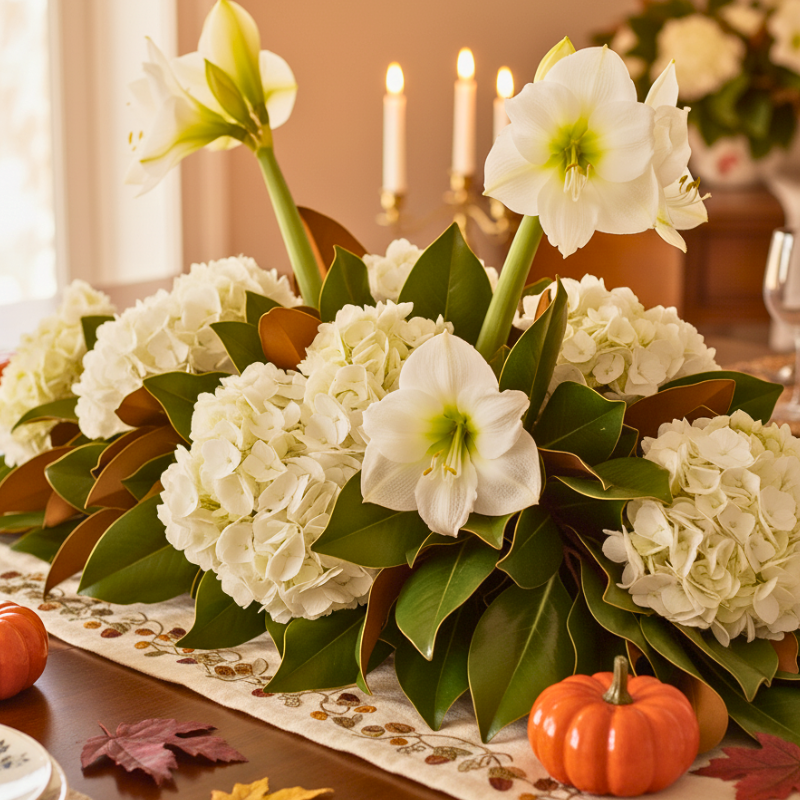
Climate Consideration: Designing for Humidity
In the South, the primary design challenge is managing humidity and the dry indoor air from air conditioning. A designer must select and condition flowers that resist browning and wilting.
Magnolia, a regional staple, requires special handling to prevent its beautiful leaves from curling prematurely. Recognizing the importance of native botanicals and their resilience is crucial for authentic and sustainable design, a practice championed by institutions like the Smithsonian Gardens.
Focus on the gloss. The South’s visual language is often high-contrast. Use glossy leaves like Magnolia, Camellia, or even Ficus for your structure, letting the light catch their surface to provide depth and a rich, luxurious texture.
Regional FAQs: The South
Will the dry air from my A/C damage the flowers?
Yes, dry and cold drafts can be very dehydrating. Place your arrangement away from direct A/C vents and consider grouping it with a few potted plants to naturally increase the humidity in the immediate area.
What are good alternatives to imported roses in the South?
Choose locally-grown garden roses or large, lush Hydrangea blooms. Both offer a wonderful sense of opulence with high petal density and are better adapted to the climate.
Can I incorporate citrus branches from my garden?
Absolutely. Citrus (like orange or lemon branches) is wonderful, but ensure the branch is freshly cut and immediately submerged in water for at least a few hours to prevent the leaves from dropping prematurely.
"We don't just sell flowers; we craft moments of welcome. The centerpiece is the emotional anchor of the table, and its beauty should last as long as the cherished memories you create."
The Midwest: Heartland Harvest (The Meadow Modernism Trend)
The Midwestern Thanksgiving is defined by a spirit of generous abundance, translated into the refined aesthetic of Meadow Modernism. This trend beautifully bridges the rustic, farm-to-table ethos with a modern, clean sensibility.
It’s a vision of practical luxury. Thanksgiving floral trends that feel deeply rooted in the harvest but are executed with contemporary precision and an artist’s eye.
Designing the Horizontal Plane: Low and Lush Tablescapes
The arrangements here are often sprawling, horizontal, and highly textural, designed to feel like a slice of a wild, cultivated field. This region is about the careful accumulation of bounty.
- Dahlias: These robust blooms deliver the rich color and density we adore, sourced from trusted growers once the local fields rest for the season.
- Dried Elements: Wheat sheaves, dried grasses, lotus pods, and cotton bolls are incorporated seamlessly to introduce a sense of preservation and longevity that speaks to the coming winter.
- Berries and Pods: Deep crimson Ilex berries or interesting seed pods add pops of saturated color and movement, preventing the design from feeling too static.
The color palette centers on terracotta, burnt orange, ochre, and sage. The vessel choice often leans toward matte, handmade ceramics or deep wood tones, underscoring the connection to the earth and craftsmanship.
The Rise of Bespoke Browns
A critical design move for 2025 is the elevation of brown. We're moving beyond basic filler into intentional, variegated shades. From the deep mahogany of dried eucalyptus to the lighter cinnamon of certain mum varieties.
This color grounds the arrangement, providing a sophisticated anchor to the brighter harvest tones. This focus aligns with global shifts toward natural palettes, as noted by trend authorities like the Flower Council of Holland.
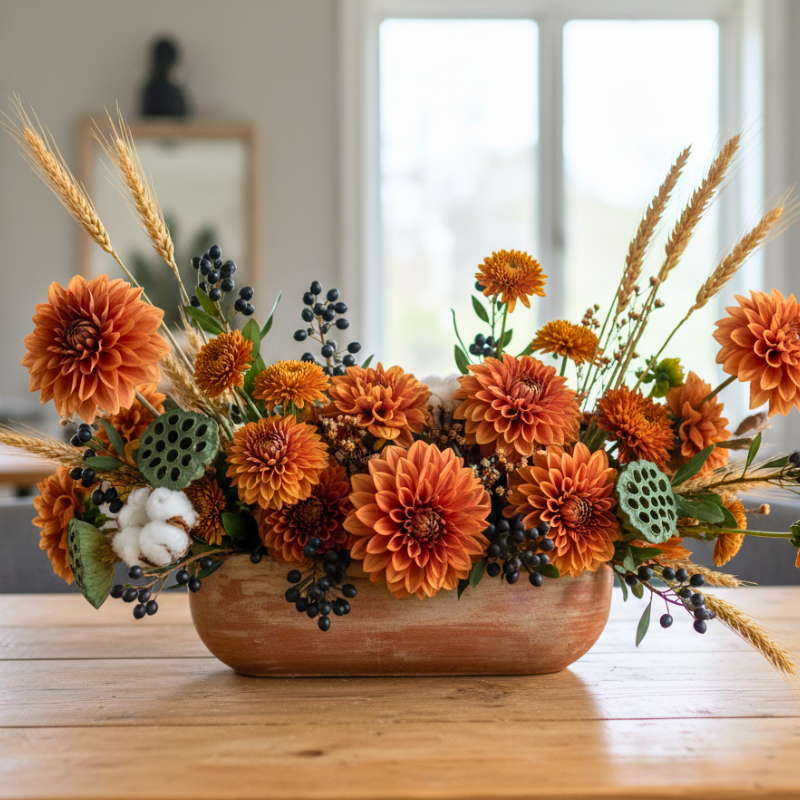
Play with density. For the Meadow Modernism trend, design with a high visual density around the base. Clusters of berries, pods, and mums. Then allow single, slender elements like wheat stalks or tall grasses to escape outward, creating the illusion of a field.
Regional FAQs: The Midwest
Which flowers are robust enough for a long day of serving?
Focus on hardier, multi-petaled blooms like Chrysanthemums, Carnations, and Sunflowers. They are less sensitive to temperature fluctuations and accidental bumps than more delicate flowers.
How should I maintain the dried materials in my centerpiece?
Dried elements like wheat or preserved grasses require no water. Keep them away from direct sunlight and moisture, and you can gently dust them with a soft paintbrush if needed.
How do I store my arrangement if I need to travel with it overnight?
If you must transport it, ask for a travel-safe box. Once at your destination, keep the arrangement in the coolest room of the house (like a garage or unheated porch) overnight to extend its vase life.
The Mountain West: Rugged Luxury (The Architectural Form Trend)
In the Mountain West, the sheer scale of the landscape from the towering peaks, the vast skies, the raw, exposed beauty demands a response in floral design. The trend here is Architectural Form, a style characterized by high drama, structure, and a deliberate use of negative space.
This is a quiet, modern thanksgiving décor where the simplicity and strength of form speak louder than an abundance of color.
The Power of Line and Negative Space
Design in this region is often vertical and linear, using tall, structural elements to draw the eye upward, mimicking the high mountain peaks and soaring interiors of modern mountain homes.
The palette is often muted and drawn from the natural surroundings. Deep charcoal grays, bleached bone whites, and the rich, cool greens of conifers.
- Structural Branches: Ponderosa Pine, lichen-covered branches, or tall cattail reeds are used to create the necessary height and form.
- Formal Blooms: A single, perfect stem of a Phalaenopsis Orchid or a large Protea is selected for its geometry and sculptural quality.
- Substantial Vessels: Containers must be weighty, often composed of raw materials like oxidized copper, cast iron, or smooth, dark stone to reflect the region's rugged geology.
True luxury thanksgiving décor is often found in restraint; an architectural arrangement uses negative space to let each element breathe and be seen. Achieving this bold, upward line requires expert mechanics to secure heavy branches and ensure stability.
The arrangement should feel both weighty and airy, with each component placed to emphasize its unique shape. This meticulous attention to composition is a key principle taught by the American Institute of Floral Designers (AIFD).
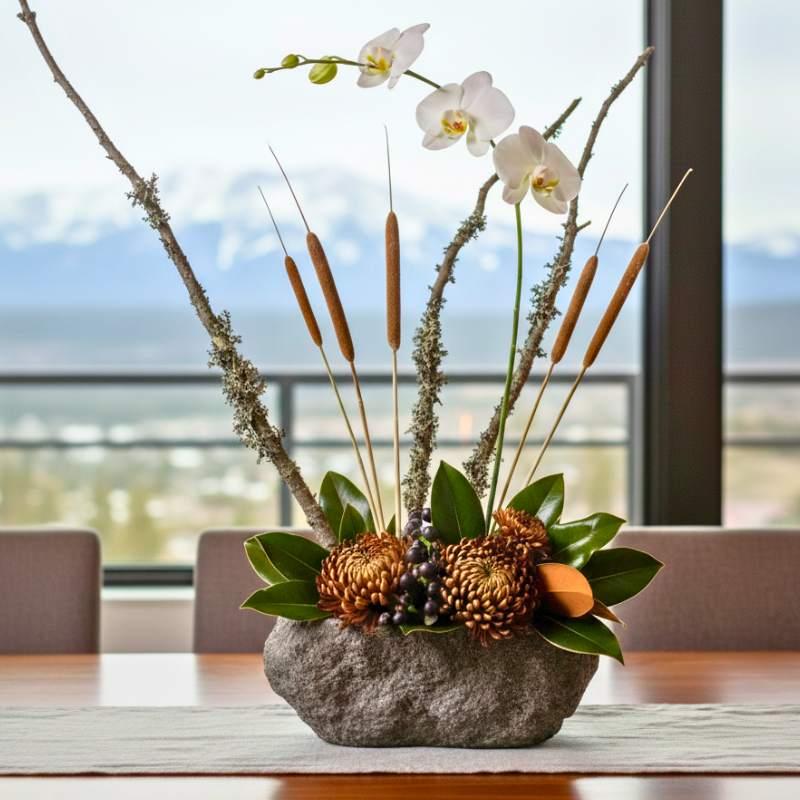
Focus on contrast. Use light and shadow to your advantage. Contrast the smooth, pale surface of a Phalaenopsis Orchid against the dark, rough texture of a Ponderosa Pine branch to amplify the dramatic, sculptural effect.
Regional FAQs: The Mountain West
How do I ensure a tall arrangement doesn't feel top-heavy?
The rule of thirds is key. Ensure the visual "weight" of the arrangement is grounded by a heavy, opaque vessel that accounts for at least one-third of the total composition’s height.
My house has radiant heat. How can I protect my flowers?
Radiant heat can create very dry air. You can place a decorative, shallow dish of water near the arrangement to introduce some local humidity through evaporation, or run a small humidifier nearby overnight.
Should I use foraged pinecones and branches in my structural arrangement?
Yes, but be sure to clean them thoroughly. A quick bath in a mild bleach solution followed by a day of drying will eliminate any potential pests or sap that could contaminate your blooms.
"True elegance is found in authenticity. In the permission to embrace the beautiful, subtle imperfections that connect us directly to the wild, natural world."
The Pacific Northwest: Organic Elegance (Intentional Imperfection)
The Pacific Northwest aesthetic is characterized by a mossy, deeply verdant, and sustainable approach, leading the trend toward Intentional Imperfection. This look is less about mass and more about mindfulness. Each arrangement feels as if it were thoughtfully gathered from a misty forest floor, celebrating the beautiful, cyclical nature of the season.
The Slow Flower Philosophy
This design is intrinsically linked to local and seasonal sourcing. The emphasis is on deep forest greens. Ferns, moss, and evergreens set against muted, fog-inspired blooms. It’s a thanksgiving centerpiece idea that feels both wild and refined.
- A Foraged Feel: Compositions incorporate delicate vines, moss, and naturally decaying leaves that feel authentic and alive.
- Muted Blooms: Creamy white garden roses, hellebores, or muted-tone ranunculus are used sparingly, allowing the rich texture of the greens to dominate.
- Organic Vessels: Containers are natural and often imperfect, such as unglazed pottery, salvaged wood, or a smooth stone bowl, reinforcing the narrative of the Slow Flower movement.
The arrangement style is typically asymmetrical, loose, and dynamic, embracing a wild, untamed movement that beautifully reflects the region’s abundant, rugged nature. It requires the designer to create visual balance not through mirroring elements, but through carefully weighting one side of the arrangement against the negative space on the other.
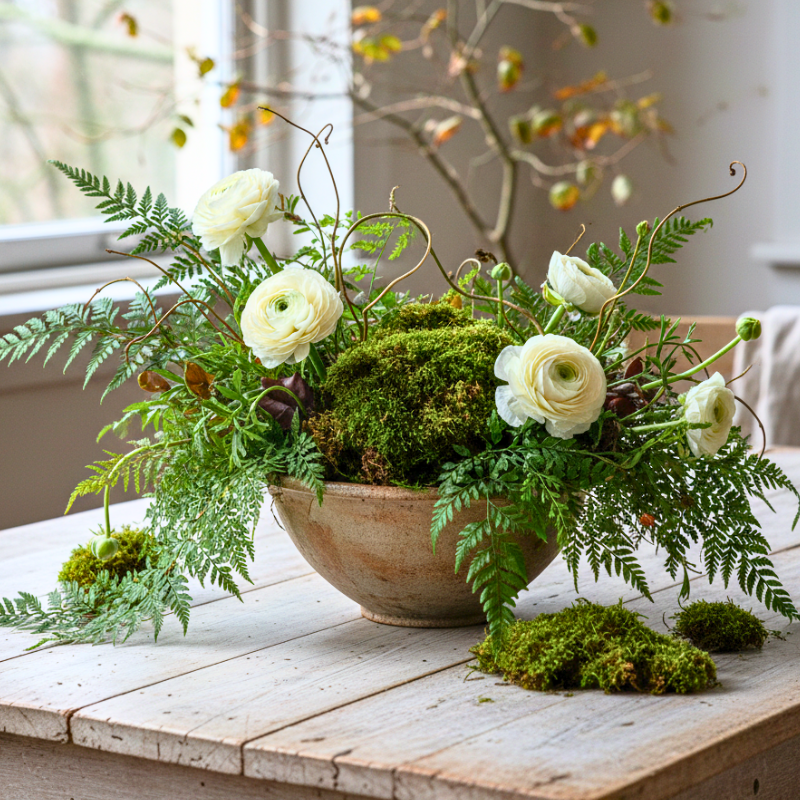
Incorporate texture from below. Don't just decorate the table surface. Use greens that spill over the table’s edge. Moss, trailing ivy, or bark fragments placed directly on the linen (safely away from food) ground the arrangement in a foraged, earthy reality.
Regional FAQs: The Pacific Northwest
What are good late-season, sustainable bloom options?
Absolutely. Look for late-season Dahlias, ornamental cabbages, and locally-grown Chrysanthemums. Focus especially on the rich variety of evergreen foliage, mosses, and branches available year-round.
How do I move an asymmetrical arrangement without disrupting it?
Always carry it from the bottom with two hands, and move slowly. If a branch shifts, you can often use a small, decorative stone placed at the base to nudge it back into position without having to handle the stems directly.
Should I use tap water or distilled water for my blooms?
Tap water is usually fine, but if you live in an area with particularly soft or highly chlorinated water, use filtered water for your final vase solution to ensure the best longevity.
A Final Reflection: Gratitude in Design
Thanksgiving is, at its heart, an emotional occasion. A pause for connection and genuine gratitude. The most successful centerpieces in 2025 will be those that feel authentic to the host and their regional story. It is a designer’s privilege to help translate those profound feelings into something beautiful and enduring.
When you choose an intentional centerpiece, you’re not just decorating a table; you’re setting the stage for a lasting memory. We believe that true luxury lies in that meticulous attention to quality and care, ensuring your arrangement serves as the perfect emotional anchor for the cherished memories you create.
To continue refining your personal design aesthetic and receive exclusive early access to our 2026 holiday floral forecast, we invite you to subscribe to The Bloom Letter.
About the Author
Emily is the founder and creative force behind Grace & Blooms in Naples, Florida. She established her boutique studio guided by a philosophy of thoughtful, narrative-driven design.
Her expertise lies in translating the emotional significance of life’s moments into bespoke floral compositions. Rooted in the Naples community, Emily is dedicated to sourcing the highest quality blooms and providing a heartfelt, luxury experience for every client.
Designer's Journal
Universal Principles: Climate, Care, and Longevity
While each region expresses Thanksgiving distinctly, universal design principles of texture, light, and grounding neutrals weave through every 2025 tablescape. But beyond aesthetics, the true hallmark of luxury is longevity.
Ensuring your investment lasts through the long holiday weekend requires addressing your local climate.
When Should I Order My Thanksgiving Centerpiece?
We strongly recommend placing your order one to two weeks early. This ensures your florist can secure the premium, unique blooms and vessels required for a true designer-level, climate-specific arrangement.
How do I protect my centerpiece in different climates?
Whether dealing with the dry indoor heat of the Mountain West or the humidity of the South, the goal is to manage hydration.
- For Dry Climates: The air in high-altitude or heated homes can be very dehydrating. Misting the air around your arrangement (not the petals directly) can create a more humid microclimate.
- For Humid Climates: In warm, humid weather, the enemy is bacterial growth. Change the water in your vase every two days and use a floral preservative to keep it clean and nourishing.
What is the ideal room temperature for flowers?
Keep your arrangement in a cool spot, ideally between 65-72°F (18-22°C), and always away from direct sunlight, drafts from open windows, or heat from radiators and appliances.
Should I keep my flowers away from my fruit bowl?
Yes, absolutely. Ripening fruit releases ethylene gas, a natural plant hormone that dramatically speeds up the aging and wilting process for most cut flowers. Keep your centerpiece and your fruit display separate for best results.
What should I do if a single bloom wilts prematurely?
Don't panic! Simply remove the spent bloom gently. Recut the stem of the healthy flowers still in the arrangement and check the water level. Removing the dead material helps prevent bacterial contamination in the water supply.
I'm hosting a large gathering. How do I select a reliable, high-quality local florist?
Look for a florist that focuses on design-driven storytelling over volume. Check their portfolio for detailed, custom work, and confirm they offer a Fresh Arrival Guarantee. This subtle commitment to quality and longevity is the hallmark of a boutique service.



Comments ()